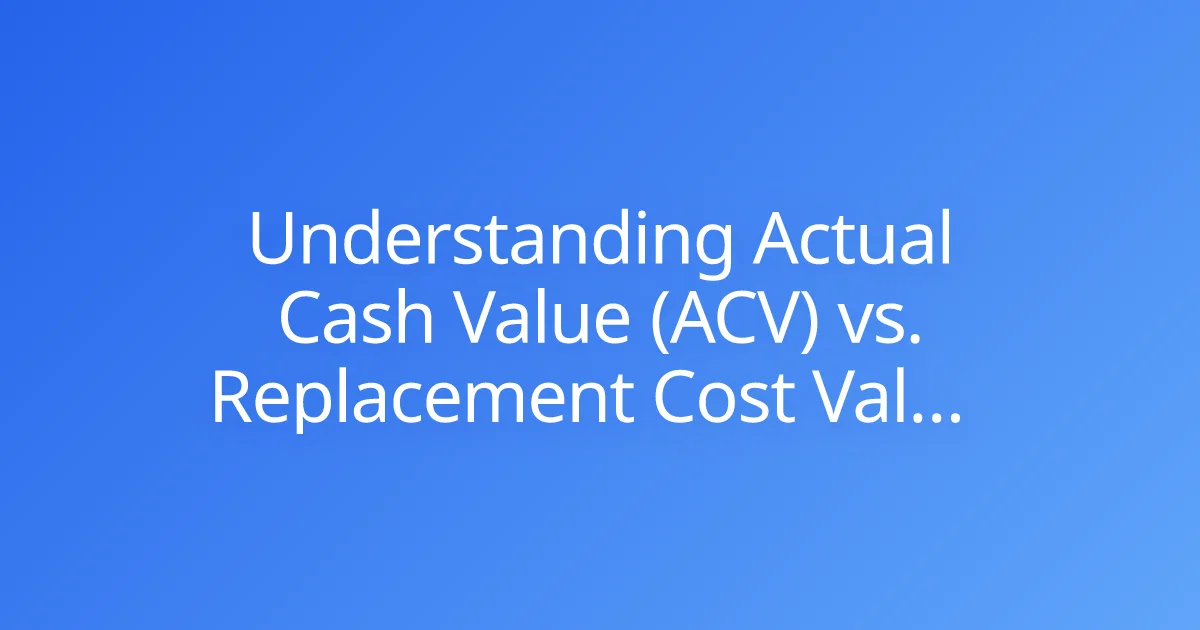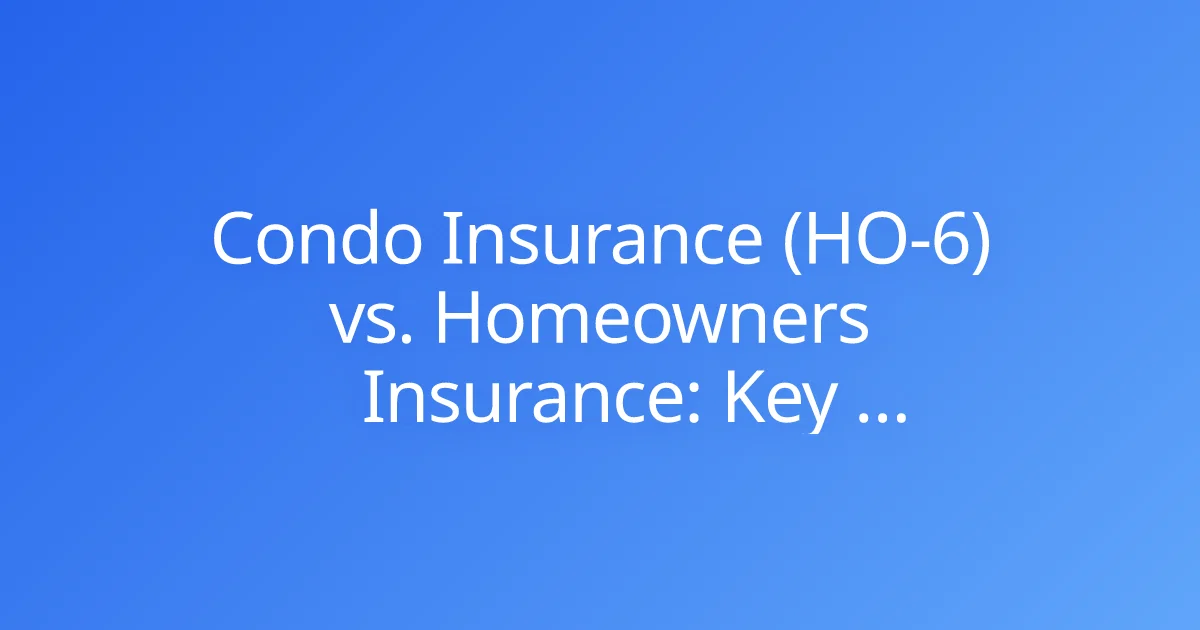Understanding Actual Cash Value (ACV) vs. Replacement Cost Value (RCV)
Imagine a storm damages your old roof, or a sudden power surge fries your five-year-old laptop. You file a claim with your homeowners or renters insurance, expecting your policy to cover the cost of a new roof or a brand-new computer. But then, you receive a payout that seems surprisingly low. Why didn't your insurance cover the full cost of replacing your old items with new ones? The answer often lies in two critical, yet commonly misunderstood, insurance terms: Actual Cash Value (ACV) and Replacement Cost Value (RCV).
At The Policy Explainer, we understand that these distinctions can be confusing, yet they fundamentally determine how much you receive during an insurance claim. This comprehensive guide will demystify Actual Cash Value (ACV) vs. Replacement Cost Value (RCV), breaking down what each term means, how they're calculated, and their significant impact on your insurance payouts and overall financial recovery. By understanding these two key coverage types, you'll be empowered to make informed decisions about your property insurance and manage your expectations during a claim.
What is Actual Cash Value (ACV)?
Actual Cash Value (ACV) is a method of valuation that pays you the cost to replace a damaged or lost item, minus depreciation. In simpler terms, it's what your item was worth at the time of the loss, not what it would cost to buy a new one today.
How ACV is Calculated (Depreciation Explained)
The core of ACV is depreciation. Depreciation is the decrease in value of an asset over time due to wear and tear, age, obsolescence, or deterioration.
The formula for ACV is generally: Replacement Cost - Depreciation = Actual Cash Value
- Replacement Cost: The cost to replace the item with a new one of similar kind and quality today.
- Depreciation: The calculated reduction in value based on the item's age, condition, and expected lifespan.
Example: You bought a television five years ago for $1,000. It had an expected lifespan of 10 years. If a fire destroys it today, its replacement cost might be $900 (for a similar new model), but it has depreciated by 50% over five years.
- Replacement Cost: $900
- Depreciation (50% of $900): $450
- ACV Payout: $900 - $450 = $450
Your insurance company would pay you $450 (minus your deductible). You would then be responsible for the remaining cost to purchase a new TV.
When ACV Policies Are Used
ACV coverage is commonly found in:
- Older Personal Property Policies: Some standard homeowners or renters policies might default to ACV for personal belongings.
- Older Vehicle Coverage: For vehicles with low market value, ACV is common.
- Roof Coverage: In some states or for older roofs, homeowners policies may pay out on an ACV basis.
- Commercial Property Insurance: ACV might be used for certain types of business property.
Pros and Cons of ACV Coverage
Pros:
- Lower Premiums: Because the insurer pays out less in the event of a claim, ACV policies typically have lower premiums compared to RCV policies.
- Simpler Payout: Often, ACV payouts are a single, lump-sum payment.
Cons:
- Less Financial Recovery: You receive less money for a claim, potentially leaving you with significant out-of-pocket costs to replace items.
- Doesn't Reflect Real-World Needs: It doesn't allow you to replace old items with new ones without personally covering the difference.
What is Replacement Cost Value (RCV)?
Replacement Cost Value (RCV) is a method of valuation that pays you the cost to replace a damaged or lost item with a new one of similar kind and quality, without any deduction for depreciation. The goal of RCV coverage is to restore your property to its original condition or replace it with a new equivalent item.
How RCV Payouts Work (Often a Two-Step Process)
RCV payouts often involve a two-step process to prevent policyholders from receiving "new for old" money and then not making the repairs or replacements.
Step 1: Initial ACV Payout.
- The insurer first pays you the Actual Cash Value of the damaged item (replacement cost minus depreciation). This is to ensure you have some funds to begin the repair or replacement process.
Step 2: Depreciation Holdback Release.
- Once you purchase the new item or complete the repairs, you provide proof (receipts, invoices) to your insurer.
- The insurer then releases the "depreciation holdback" – the difference between the ACV and the RCV, up to the actual cost of replacement and within your policy limits.
Example (Continuing from ACV example): You bought a television five years ago for $1,000. Its replacement cost is $900.
- Initial ACV Payout: $450 (minus your deductible, let's assume it was already met for this example)
- You buy a new TV for $900.
- You submit the receipt to your insurer.
- The insurer then pays you the depreciation holdback: $900 (RCV) - $450 (ACV) = $450.
- Total RCV Payout: $450 (initial) + $450 (depreciation holdback) = $900 (the full replacement cost).
When RCV Policies Are Preferred
RCV coverage is generally the preferred choice for most policyholders because it offers more comprehensive protection. It is common for:
- Newer Homeowners Policies: Most homeowners insurance policies offer RCV for the dwelling and often for personal property (though personal property might still have an ACV default, requiring an RCV endorsement).
- Newer Vehicle Coverage: For newer cars, RCV is implied through "total loss" payouts that reflect the vehicle's market value without significant depreciation.
Pros and Cons of RCV Coverage
Pros:
- Fuller Financial Recovery: You receive enough money to replace old items with new ones, or rebuild your property without significant out-of-pocket expenses (beyond your deductible).
- Better Peace of Mind: You're more fully protected against rising replacement costs.
Cons:
- Higher Premiums: Because the insurer takes on more risk and potential payout, RCV policies generally have higher premiums.
- More Complex Payout Process: The two-step payout process can be more involved, requiring you to make the initial replacement/repair and submit documentation.
ACV vs. RCV: The Key Differences at a Glance
| Feature | Actual Cash Value (ACV) | Replacement Cost Value (RCV) |
|---|---|---|
| Payout Calculation | Replacement Cost - Depreciation | Replacement Cost (no depreciation deduction) |
| What You Get | What the item was worth at the time of loss (used price) | Cost to replace with a new equivalent item (new price) |
| Impact on You | Larger out-of-pocket expense to replace/repair | Generally less out-of-pocket expense (beyond deductible) |
| Premium Cost | Lower premiums | Higher premiums |
| Payout Process | Typically single payment | Often a two-step process (ACV first, then depreciation holdback) |
| Goal of Coverage | Compensate for current value | Restore to pre-loss condition with new items |
Choosing Between ACV and RCV: What's Right for You?
The decision between Actual Cash Value (ACV) and Replacement Cost Value (RCV) hinges on your financial situation, risk tolerance, and the specific items you're insuring.
Factors to Consider When Deciding
- Your Budget for Premiums: If paying the lowest possible premium is your absolute top priority, ACV might be considered, but be aware of the trade-off.
- Your Financial Comfort Level for Out-of-Pocket Costs: Can you comfortably afford to cover the difference between ACV and RCV after a loss? If not, RCV is likely a better choice.
- The Age and Condition of Your Property/Items: For older homes, roofs, or personal property, the depreciation under an ACV policy can be substantial, leading to very low payouts. RCV offers much better protection in these cases.
- Your Risk Tolerance: Are you willing to absorb more of the financial burden in exchange for lower monthly costs, or do you prefer maximum coverage and peace of mind?
Real-World Scenarios for Decision Making
- Older Home/Roof: If you have an older roof that would depreciate significantly, choosing RCV coverage for your dwelling is almost always advisable, even with a higher premium. Otherwise, a roof replacement after a storm could cost you thousands out-of-pocket.
- High-Value Personal Property: For valuable items like electronics, furniture, or appliances, RCV coverage on your personal property can make a big difference. An ACV policy might only give you pennies on the dollar for items you need to replace.
- Budget Constraints: If your budget is extremely tight, ACV might be the only option you can afford initially. However, work towards upgrading to RCV as soon as possible by building up an emergency fund to cover the potential gap.
- Collector's Items/Antiques: For items whose value appreciates (like art or rare collectibles), neither standard ACV nor RCV may be suitable. These often require a specialized Scheduled Personal Property endorsement that insures them for an agreed-upon value.
Impact on Your Premiums and Claim Experience
The choice between ACV and RCV directly affects your wallet and your experience during a claim.
Premium Implications
- RCV is More Expensive: Insurers take on a greater risk with RCV policies because they commit to paying for new replacement items regardless of the old item's depreciation. This increased risk is reflected in higher premiums.
- ACV is Cheaper: Conversely, ACV policies carry lower premiums because the insurer's potential payout is reduced by depreciation.
The Claims Process and Payouts
- RCV: Two Steps, Fuller Recovery: While the two-step payout process of RCV might seem more complex, it ultimately leads to a much fuller financial recovery, allowing you to restore your property without incurring significant unplanned expenses.
- ACV: Single Step, Less Recovery: ACV is simpler in that it's a single payment, but you'll likely have to pay a substantial amount out of your own pocket to replace items.
- Documentation is Key for RCV: To receive the depreciation holdback on an RCV policy, you must provide documentation (receipts) proving you actually replaced the items or completed the repairs.
Ensuring Proper Documentation
Regardless of whether you have ACV or RCV coverage, maintaining a detailed home inventory (with photos, videos, and receipts) is crucial. This speeds up the claims process and helps prove the value of your possessions. For RCV, these receipts are essential for getting your full payout.
Conclusion
Understanding Actual Cash Value (ACV) vs. Replacement Cost Value (RCV) is fundamental to knowing the true extent of your insurance protection. While ACV offers lower premiums by accounting for depreciation, it can leave you with a significant financial gap when replacing damaged property. RCV, though more expensive upfront, provides a much more comprehensive payout, allowing you to restore your assets to their original condition without substantial out-of-pocket costs.
The ideal choice balances your budget with your desire for complete financial recovery. By carefully considering your assets, risk tolerance, and financial comfort level, you can select the coverage that best fits your needs, ensuring that your insurance policy truly performs as your ultimate safety net when you need it most. Do you have specific questions about how to determine the ACV or RCV for a particular item, or want to explore adding an RCV endorsement to your current policy?



